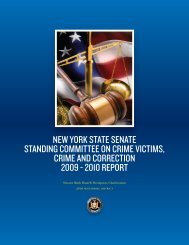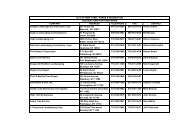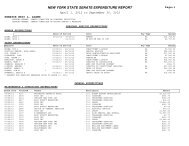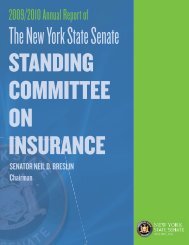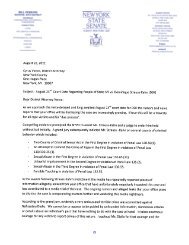IDC OCFS report.pdf - New York State Senate
IDC OCFS report.pdf - New York State Senate
IDC OCFS report.pdf - New York State Senate
You also want an ePaper? Increase the reach of your titles
YUMPU automatically turns print PDFs into web optimized ePapers that Google loves.
IV. Overtime Spending at <strong>OCFS</strong><br />
The <strong>State</strong> is spending hundreds of millions of dollars in overtime each year with very little<br />
control exercised by the agencies themselves. The <strong>IDC</strong> recognizes the fact that there are times<br />
when overtime is a cost effective method of making sure that all necessary shifts are filled,<br />
particularly true at agencies that oversee 24 hour facilities, like <strong>OCFS</strong>. However, excessive<br />
overtime spending can point to inefficiencies in the management of work hours and significant<br />
disparities in overtime spending at various facilities can indicate a lack of workforce hour<br />
oversight.<br />
While <strong>OCFS</strong> runs a number of 24 hour facilities, the number of workforce earning overtime is<br />
much smaller than that at some of the agencies previously examined by the <strong>Senate</strong> Task Force.<br />
In Calendar Year 2009 (CY 2009), 2,190 employees were recorded by the Office of the<br />
Comptroller as earning overtime (this includes less than a dozen employees recorded as having<br />
“earned” negative overtime, employees who had to reimburse the state for incorrect overtime<br />
pay). These employees earned a total of $11.6 million in overtime. <strong>OCFS</strong> comes in 9 th in terms of<br />
overtime spending by <strong>State</strong> agencies.<br />
As noted in the <strong>IDC</strong>’s <strong>report</strong> summarizing the findings of the Task Force, one of the recurring<br />
issues that came up in those <strong>report</strong>s was a very uneven distribution of overtime earnings by the<br />
overtime-eligible employees. A small number of employees earn the bulk of overtime. For<br />
example, as shown below, less than 2% of the workforce earns over 15% of the overtime.<br />
OT Earning<br />
employees 2009<br />
Amount<br />
Earned OT Earned % of OT Earned<br />
% Of OT Earning<br />
employees<br />
5 Over $70,000 $394,372.72 3.39% 0.23%<br />
13 Over $50,000 $843,653.37 7.24% 0.60%<br />
22 Over $40,000 $1,259,641.47 10.82% 1.01%<br />
40 Over $30,000 $1,887,922.19 16.21% 1.84%<br />
101 Over $20,000 $3,359,029.19 28.84% 4.64%<br />
325 Over $10,000 $6,454,564.67 55.43% 14.92%<br />
703 Over $5,000 $9,161,396.46 78.67% 32.26%<br />
2179 More than $0 $11,645,537.64 100% 100%<br />
In examining where overtime was being spent in CY 2009, it is clear that those classes of<br />
employees who serve at the 24 hour juvenile centers run by <strong>OCFS</strong> account for most of the<br />
overtime spending. This is similar to trends found by the <strong>Senate</strong> Task Force in its previous<br />
<strong>report</strong>s on OPWDD and DOCS. Youth Division Aides, whose job it is to perform various youth<br />
care tasks in limited secure and non-secure facilities, accounted for the bulk of the overtime<br />
earnings. Youth Division aides levels two through four accounted for 59% of the overtime<br />
earning employees and earned 72% of the overtime paid.



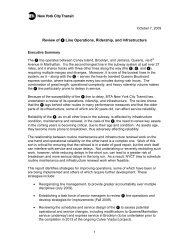


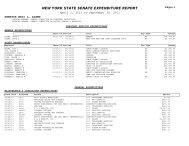
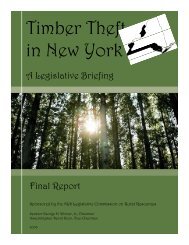

![[PDF] Proposed MTA Capital Program - New York State Senate](https://img.yumpu.com/24854139/1/190x245/pdf-proposed-mta-capital-program-new-york-state-senate.jpg?quality=85)

